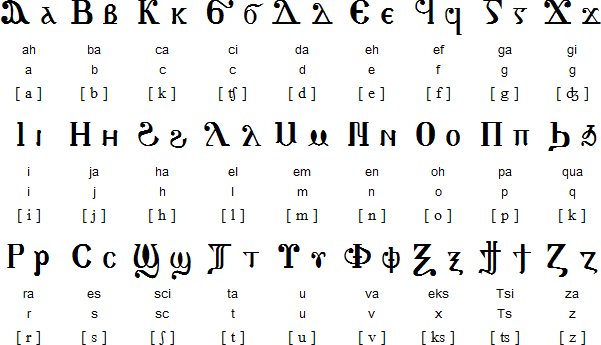This is a system for writing Latin (Catholic Latin) using the Coptic Alphabet invented by David Biliot, who uses it to teach Latin to English speaking students. The reason he uses this is to overcome several of the difficulties encountered by English speaking students when they approach Catholic Latin for the first time. They often will already have some Latin background, usually in Classical Latin, that will interfere with the course of study he's teaching them.
As a way to remedy this, he uses the Coptic Alphabet. By doing this, He can specifically teach them and reinforce within them the places and times when Catholic Latin has sound changes in the consonants. He does this by making the student use a completely different letter to denote the sound change. This also allows him to overcome another difficulty that English speaking students often encounter and that is vowel changes.
In Catholic Latin, vowels never change sound, though they may change length. By instructing them that a different sound in the Coptic Alphabet will have a different letter, the fact that none of the vowel sounds have a different letter reinforces the Catholic Latin rule that vowels never change sound. Coptic works well for this purpose because the letter shapes of many of the letters are familiar to the student but many are also very new. This allows the student to be in familiar territory but at the same time to know that this alphabet works different from the one they have been using their whole life and so they are open to being told exactly how it works and not expecting it to work as English.
He also points out to the students that he has taken several liberties with the alphabet, and not to approach a real Coptic piece of writing and used the sounds they have learned from him. He only uses the Coptic alphabet in the opening stages of study, until the students have a good vocabulary and have minimum conversational skills. At that point he switches to the Latin Alphabet but by then, the places where there are sound changes have already been learned and the student can proceed without thinking that GI equals GHI. Many students do usually become at least mildly interested in the Coptic language and this becomes a doorway to teaching about the other forms of Eastern Catholicism other than the Byzantines.
In the future he hopes these kinds of uses of Coptic letters will allow Copts greater fidelity with Catholics.


Omnes homines dignitate et jure liberi et pares nascuntur, rationis et conscientiae participes sunt, quibus inter se concordiae studio est agendum.
All human beings are born free and equal in dignity and rights. They
are endowed with reason and conscience and should act towards one another
in a spirit of brotherhood.
(Article 1 of the Universal Declaration of Human Rights)
If you have any questions about the Coptic Latin, you can contact David at: davidbilliot@hotmail.com
Constructed scripts for: Ainu | Arabic | Chinese languages | Dutch | English | Hawaiian | Hungarian | Japanese | Korean | Lingala | Malay & Indonesian | Persian | Tagalog / Filipino | Russian | Sanskrit | Spanish | Taino | Turkish | Vietnamese | Welsh | Other natural languages | Colour-based scripts | Tactile scripts | Phonetic/universal scripts | Constructed scripts for constructed languages | Adaptations of existing alphabets | Fictional alphabets | Magical alphabets | A-Z index | How to submit a constructed script
[top]
You can support this site by Buying Me A Coffee, and if you like what you see on this page, you can use the buttons below to share it with people you know.

If you like this site and find it useful, you can support it by making a donation via PayPal or Patreon, or by contributing in other ways. Omniglot is how I make my living.
Note: all links on this site to Amazon.com, Amazon.co.uk
and Amazon.fr
are affiliate links. This means I earn a commission if you click on any of them and buy something. So by clicking on these links you can help to support this site.
[top]